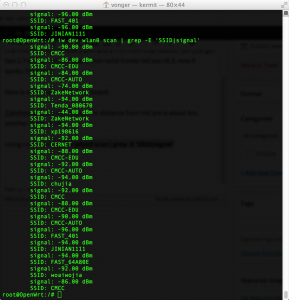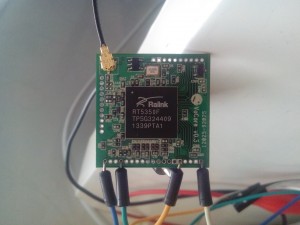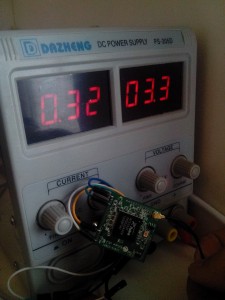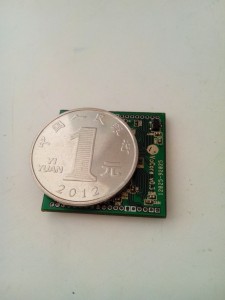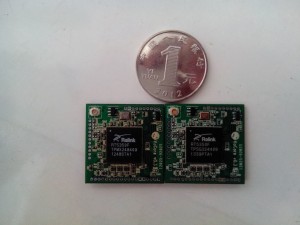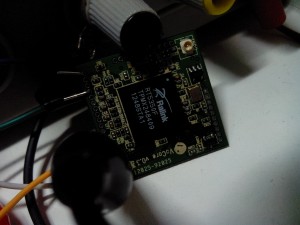After get out that RT5350F from the board, I find the solder is normal. Every ball touched its pad, so this might not be solder problem.
I have to check software again. Get boot log from normal board and the bug board again, compare the two.
normal one:
U-Boot 1.1.3 (Nov 26 2013 - 19:17:30)
Board: Ralink APSoC DRAM: 32 MB relocate_code Pointer at: 81fb4000 ****************************** Software System Reset Occurred ****************************** spi_wait_nsec: 42 spi device id: ef 40 17 0 0 (40170000) find flash: W25Q64BV raspi_read: from:30000 len:1000 .*** Warning - bad CRC, using default environment
============================================ Ralink UBoot Version: 4.0.0.0 -------------------------------------------- ASIC 5350_MP (Port5<->None) DRAM_CONF_FROM: Boot-Strapping DRAM_TYPE: SDRAM DRAM_SIZE: 256 Mbits DRAM_WIDTH: 16 bits DRAM_TOTAL_WIDTH: 16 bits TOTAL_MEMORY_SIZE: 32 MBytes Flash component: SPI Flash Date:Nov 26 2013 Time:19:17:30 ============================================ icache: sets:256, ways:4, linesz:32 ,total:32768 dcache: sets:128, ways:4, linesz:32 ,total:16384
##### The CPU freq = 360 MHZ #### estimate memory size =32 Mbytes
Please choose the operation: 1: Load system code to SDRAM via TFTP. 2: Load system code then write to Flash via TFTP. 3: Boot system code via Flash (default). 4: Entr boot command line interface. 7: Load Boot Loader code then write to Flash via Serial. 9: Load Boot Loader code then write to Flash via TFTP. 4 You choosed 3
0 3: System Boot system code via Flash. ## Booting image at bc050000 ... raspi_read: from:50000 len:40 . Image Name: MIPS OpenWrt Linux-3.10.32 Created: 2014-03-20 13:56:37 UTC Image Type: MIPS Linux Kernel Image (lzma compressed) Data Size: 981825 Bytes = 958.8 kB Load Address: 80000000 Entry Point: 80000000 raspi_read: from:50040 len:efb41 ............... Verifying Checksum ... OK Uncompressing Kernel Image ... OK No initrd ## Transferring control to Linux (at address 80000000) ... ## Giving linux memsize in MB, 32
Starting kernel ...
[ 0.000000] Linux version 3.10.32 (vonger@debian) (gcc version 4.8.3 (OpenWrt/Linaro GCC 4.8-2014.01 r39957) ) #3 Thu Mar 20 21:56:24 HKT 2014 [ 0.000000] SoC Type: Ralink RT5350 id:1 rev:3 [ 0.000000] bootconsole [early0] enabled [ 0.000000] CPU revision is: 0001964c (MIPS 24KEc) [ 0.000000] MIPS: machine is VoCore v0.3 [ 0.000000] Determined physical RAM map: [ 0.000000] memory: 02000000 @ 00000000 (usable) [ 0.000000] Initrd not found or empty - disabling initrd [ 0.000000] Zone ranges: [ 0.000000] Normal [mem 0x00000000-0x01ffffff] [ 0.000000] Movable zone start for each node [ 0.000000] Early memory node ranges [ 0.000000] node 0: [mem 0x00000000-0x01ffffff] [ 0.000000] Primary instruction cache 32kB, VIPT, 4-way, linesize 32 bytes. [ 0.000000] Primary data cache 16kB, 4-way, VIPT, no aliases, linesize 32 bytes [ 0.000000] Built 1 zonelists in Zone order, mobility grouping on. Total pages: 8128 [ 0.000000] Kernel command line: console=ttyS0,57600 rootfstype=squashfs,jffs2 [ 0.000000] PID hash table entries: 128 (order: -3, 512 bytes) [ 0.000000] Dentry cache hash table entries: 4096 (order: 2, 16384 bytes) [ 0.000000] Inode-cache hash table entries: 2048 (order: 1, 8192 bytes) [ 0.000000] Writing ErrCtl register=0007a400 [ 0.000000] Readback ErrCtl register=0007a400 [ 0.000000] Memory: 29356k/32768k available (2132k kernel code, 3412k reserved, 544k data, 200k init, 0k highmem) [ 0.000000] SLUB: HWalign=32, Order=0-3, MinObjects=0, CPUs=1, Nodes=1 [ 0.000000] NR_IRQS:256 [ 0.000000] CPU Clock: 360MHz [ 0.000000] Calibrating delay loop... 239.61 BogoMIPS (lpj=1198080) [ 0.070000] pid_max: default: 32768 minimum: 301 [ 0.070000] Mount-cache hash table entries: 512 [ 0.080000] pinctrl core: initialized pinctrl subsystem [ 0.090000] NET: Registered protocol family 16 [ 0.130000] bio: create slab <bio-0> at 0 [ 0.140000] rt2880_gpio 10000600.gpio: registering 24 gpios [ 0.150000] rt2880_gpio 10000600.gpio: registering 24 irq handlers [ 0.160000] Switching to clocksource MIPS [ 0.170000] NET: Registered protocol family 2 [ 0.180000] TCP established hash table entries: 512 (order: 0, 4096 bytes) [ 0.200000] TCP bind hash table entries: 512 (order: -1, 2048 bytes) [ 0.210000] TCP: Hash tables configured (established 512 bind 512) [ 0.220000] TCP: reno registered [ 0.230000] UDP hash table entries: 256 (order: 0, 4096 bytes) [ 0.240000] UDP-Lite hash table entries: 256 (order: 0, 4096 bytes) [ 0.250000] NET: Registered protocol family 1 [ 0.260000] rt-timer 10000100.timer: maximum frequncy is 7324Hz [ 0.310000] squashfs: version 4.0 (2009/01/31) Phillip Lougher [ 0.330000] jffs2: version 2.2 (NAND) (SUMMARY) (LZMA) (RTIME) (CMODE_PRIORITY) (c) 2001-2006 Red Hat, Inc. [ 0.350000] msgmni has been set to 57 [ 0.360000] io scheduler noop registered [ 0.360000] io scheduler deadline registered (default) [ 0.380000] Serial: 8250/16550 driver, 2 ports, IRQ sharing disabled [ 0.390000] 10000c00.uartlite: ttyS0 at MMIO 0x10000c00 (irq = 20) is a 16550A [ 0.410000] console [ttyS0] enabled, bootconsole disabled [ 0.410000] console [ttyS0] enabled, bootconsole disabled [ 0.440000] m25p80 spi32766.0: found s25fl064k, expected gd25q64 [ 0.450000] m25p80 spi32766.0: s25fl064k (8192 Kbytes) [ 0.460000] 4 ofpart partitions found on MTD device spi32766.0 [ 0.470000] Creating 4 MTD partitions on "spi32766.0": [ 0.480000] 0x000000000000-0x000000030000 : "u-boot" [ 0.500000] 0x000000030000-0x000000040000 : "u-boot-env" [ 0.510000] 0x000000040000-0x000000050000 : "factory" [ 0.530000] 0x000000050000-0x000000800000 : "firmware" [ 0.540000] 0x00000013fb81-0x000000800000 : "rootfs" [ 0.550000] mtd: partition "rootfs" must either start or end on erase block boundary or be smaller than an erase block -- forcing read-only [ 0.580000] mtd: device 4 (rootfs) set to be root filesystem [ 0.590000] mtd: partition "rootfs_data" created automatically, ofs=0x360000, len=0x4a0000 [ 0.610000] 0x000000360000-0x000000800000 : "rootfs_data" [ 0.630000] eth0: done loading [ 0.640000] rt3xxx-usbphy ubsphy.3: loaded [ 0.650000] rt2880_wdt 10000120.watchdog: Initialized [ 0.660000] TCP: cubic registered [ 0.670000] NET: Registered protocol family 17 [ 0.680000] 8021q: 802.1Q VLAN Support v1.8 [ 0.710000] VFS: Mounted root (squashfs filesystem) readonly on device 31:4. [ 0.720000] Freeing unused kernel memory: 200K (8029e000 - 802d0000) procd: Console is alive procd: - watchdog - procd: - preinit - [ 7.100000] rt305x-esw 10110000.esw: link changed 0x00 Press the [f] key and hit [enter] to enter failsafe mode Press the [1], [2], [3] or [4] key and hit [enter] to select the debug level [ 8.220000] usbcore: registered new interface driver usbfs [ 8.230000] usbcore: registered new interface driver hub [ 8.240000] usbcore: registered new device driver usb [ 8.260000] dwc_otg: version 2.72a 24-JUN-2008 jffs2 is ready [ 10.910000] jffs2: notice: (260) jffs2_build_xattr_subsystem: complete building xattr subsystem, 1 of xdatum (0 unchecked, 0 orphan) and 11 of xref (0 dead, 0 orphan) found. switching to jffs2 procd: - early - procd: - watchdog - procd: - ubus - procd: - init - Please press Enter to activate this console. [ 14.730000] NET: Registered protocol family 10 [ 14.750000] l2tp_core: L2TP core driver, V2.0 [ 14.760000] l2tp_netlink: L2TP netlink interface [ 14.780000] nf_conntrack version 0.5.0 (461 buckets, 1844 max) [ 14.810000] ip6_tables: (C) 2000-2006 Netfilter Core Team [ 14.850000] Loading modules backported from Linux version master-2014-01-23-0-g62c147d [ 14.860000] Backport generated by backports.git backports-20140124-0-g1256d3e [ 14.890000] ip_tables: (C) 2000-2006 Netfilter Core Team [ 14.960000] xt_time: kernel timezone is -0000 [ 15.020000] cfg80211: Calling CRDA to update world regulatory domain [ 15.040000] cfg80211: World regulatory domain updated: [ 15.050000] cfg80211: DFS Master region: unset [ 15.050000] cfg80211: (start_freq - end_freq @ bandwidth), (max_antenna_gain, max_eirp) [ 15.070000] cfg80211: (2402000 KHz - 2472000 KHz @ 40000 KHz), (300 mBi, 2000 mBm) [ 15.090000] cfg80211: (2457000 KHz - 2482000 KHz @ 40000 KHz), (300 mBi, 2000 mBm) [ 15.100000] cfg80211: (2474000 KHz - 2494000 KHz @ 20000 KHz), (300 mBi, 2000 mBm) [ 15.120000] cfg80211: (5170000 KHz - 5250000 KHz @ 80000 KHz), (300 mBi, 2000 mBm) [ 15.130000] cfg80211: (5735000 KHz - 5835000 KHz @ 80000 KHz), (300 mBi, 2000 mBm) [ 15.150000] cfg80211: (57240000 KHz - 63720000 KHz @ 2160000 KHz), (N/A, 0 mBm) [ 15.260000] PPP generic driver version 2.4.2 [ 15.280000] NET: Registered protocol family 24 [ 15.330000] ieee80211 phy0: rt2x00_set_rt: Info - RT chipset 5350, rev 0500 detected [ 15.350000] ieee80211 phy0: rt2x00_set_rf: Info - RF chipset 5350 detected procd: - init complete - [ 29.350000] device eth0.1 entered promiscuous mode [ 29.360000] device eth0 entered promiscuous mode [ 29.380000] br-lan: port 1(eth0.1) entered forwarding state [ 29.390000] br-lan: port 1(eth0.1) entered forwarding state [ 30.470000] IPv6: ADDRCONF(NETDEV_CHANGE): eth0.1: link becomes ready [ 31.390000] br-lan: port 1(eth0.1) entered forwarding state [ 32.790000] IPv6: ADDRCONF(NETDEV_UP): wlan0: link is not ready [ 32.800000] device wlan0 entered promiscuous mode [ 32.840000] br-lan: port 2(wlan0) entered forwarding state [ 32.850000] br-lan: port 2(wlan0) entered forwarding state [ 32.860000] IPv6: ADDRCONF(NETDEV_CHANGE): wlan0: link becomes ready [ 34.850000] br-lan: port 2(wlan0) entered forwarding state
bug one:
U-Boot 1.1.3 (Feb 15 2014 - 15:46:39)
Board: Ralink APSoC DRAM: 32 MB relocate_code Pointer at: 81fb4000 ****************************** Software System Reset Occurred ****************************** spi_wait_nsec: 42 spi device id: ef 40 17 0 0 (40170000) find flash: W25Q64BV raspi_read: from:30000 len:1000 .*** Warning - bad CRC, using default environment
============================================ Ralink UBoot Version: 4.0.0.0 -------------------------------------------- ASIC 5350_MP (Port5<->None) DRAM_CONF_FROM: Boot-Strapping DRAM_TYPE: SDRAM DRAM_SIZE: 256 Mbits DRAM_WIDTH: 16 bits DRAM_TOTAL_WIDTH: 16 bits TOTAL_MEMORY_SIZE: 32 MBytes Flash component: SPI Flash Date:Feb 15 2014 Time:15:46:39 ============================================ icache: sets:256, ways:4, linesz:32 ,total:32768 dcache: sets:128, ways:4, linesz:32 ,total:16384
##### The CPU freq = 360 MHZ #### estimate memory size =32 Mbytes
Please choose the operation: 1: Load system code to SDRAM via TFTP. 2: Load system code then write to Flash via TFTP. 3: Boot system code via Flash (default). 4: Entr boot command line interface. 7: Load Boot Loader code then write to Flash via Serial. 9: Load Boot Loader code then write to Flash via TFTP. 3 You choosed 3
0 3: System Boot system code via Flash. ## Booting image at bc050000 ... raspi_read: from:50000 len:40 . Image Name: MIPS OpenWrt Linux-3.10.32 Created: 2014-03-20 9:29:45 UTC Image Type: MIPS Linux Kernel Image (lzma compressed) Data Size: 981903 Bytes = 958.9 kB Load Address: 80000000 Entry Point: 80000000 raspi_read: from:50040 len:efb8f ............... Verifying Checksum ... OK Uncompressing Kernel Image ... OK No initrd ## Transferring control to Linux (at address 80000000) ... ## Giving linux memsize in MB, 32
Starting kernel ...
[ 0.000000] Linux version 3.10.32 (vonger@debian) (gcc version 4.8.3 (OpenWrt/Linaro GCC 4.8-2014.01 r39957) ) #1 Thu Mar 20 17:27:09 HKT 2014 [ 0.000000] SoC Type: Ralink RT5350 id:1 rev:3 [ 0.000000] bootconsole [early0] enabled [ 0.000000] CPU revision is: 0001964c (MIPS 24KEc) [ 0.000000] MIPS: machine is Poray X8 [ 0.000000] Determined physical RAM map: [ 0.000000] memory: 02000000 @ 00000000 (usable) [ 0.000000] Initrd not found or empty - disabling initrd [ 0.000000] Zone ranges: [ 0.000000] Normal [mem 0x00000000-0x01ffffff] [ 0.000000] Movable zone start for each node [ 0.000000] Early memory node ranges [ 0.000000] node 0: [mem 0x00000000-0x01ffffff] [ 0.000000] Primary instruction cache 32kB, VIPT, 4-way, linesize 32 bytes. [ 0.000000] Primary data cache 16kB, 4-way, VIPT, no aliases, linesize 32 bytes [ 0.000000] Built 1 zonelists in Zone order, mobility grouping on. Total pages: 8128 [ 0.000000] Kernel command line: console=ttyS0,57600 rootfstype=squashfs,jffs2 [ 0.000000] PID hash table entries: 128 (order: -3, 512 bytes) [ 0.000000] Dentry cache hash table entries: 4096 (order: 2, 16384 bytes) [ 0.000000] Inode-cache hash table entries: 2048 (order: 1, 8192 bytes) [ 0.000000] Writing ErrCtl register=0003afe0 [ 0.000000] Readback ErrCtl register=0003afe0 [ 0.000000] Memory: 29352k/32768k available (2132k kernel code, 3416k reserved, 544k data, 200k init, 0k highmem) [ 0.000000] SLUB: HWalign=32, Order=0-3, MinObjects=0, CPUs=1, Nodes=1 [ 0.000000] NR_IRQS:256 [ 0.000000] CPU Clock: 360MHz [ 0.000000] Calibrating delay loop... 239.61 BogoMIPS (lpj=1198080) [ 0.070000] pid_max: default: 32768 minimum: 301 [ 0.070000] Mount-cache hash table entries: 512 [ 0.080000] pinctrl core: initialized pinctrl subsystem [ 0.090000] NET: Registered protocol family 16 [ 0.140000] bio: create slab <bio-0> at 0 [ 0.150000] rt2880_gpio 10000600.gpio: registering 24 gpios [ 0.160000] rt2880_gpio 10000600.gpio: registering 24 irq handlers [ 0.170000] Switching to clocksource MIPS [ 0.180000] NET: Registered protocol family 2 [ 0.190000] TCP established hash table entries: 512 (order: 0, 4096 bytes) [ 0.210000] TCP bind hash table entries: 512 (order: -1, 2048 bytes) [ 0.220000] TCP: Hash tables configured (established 512 bind 512) [ 0.230000] TCP: reno registered [ 0.240000] UDP hash table entries: 256 (order: 0, 4096 bytes) [ 0.250000] UDP-Lite hash table entries: 256 (order: 0, 4096 bytes) [ 0.260000] NET: Registered protocol family 1 [ 0.270000] rt-timer 10000100.timer: maximum frequncy is 7324Hz [ 0.320000] squashfs: version 4.0 (2009/01/31) Phillip Lougher [ 0.330000] jffs2: version 2.2 (NAND) (SUMMARY) (LZMA) (RTIME) (CMODE_PRIORITY) (c) 2001-2006 Red Hat, Inc. [ 0.360000] msgmni has been set to 57 [ 0.370000] io scheduler noop registered [ 0.370000] io scheduler deadline registered (default) [ 0.390000] Serial: 8250/16550 driver, 2 ports, IRQ sharing disabled [ 0.400000] 10000c00.uartlite: ttyS0 at MMIO 0x10000c00 (irq = 20) is a 16550A [ 0.420000] console [ttyS0] enabled, bootconsole disabled [ 0.420000] console [ttyS0] enabled, bootconsole disabled [ 0.450000] m25p80 spi32766.0: found s25fl064k, expected gd25q64 [ 0.460000] m25p80 spi32766.0: s25fl064k (8192 Kbytes) [ 0.470000] 4 ofpart partitions found on MTD device spi32766.0 [ 0.480000] Creating 4 MTD partitions on "spi32766.0": [ 0.490000] 0x000000000000-0x000000030000 : "u-boot" [ 0.510000] 0x000000030000-0x000000040000 : "u-boot-env" [ 0.520000] 0x000000040000-0x000000050000 : "factory" [ 0.540000] 0x000000050000-0x000000800000 : "firmware" [ 0.550000] 0x00000013fbcf-0x000000800000 : "rootfs" [ 0.560000] mtd: partition "rootfs" must either start or end on erase block boundary or be smaller than an erase block -- forcing read-only [ 0.590000] mtd: device 4 (rootfs) set to be root filesystem [ 0.600000] mtd: partition "rootfs_data" created automatically, ofs=0x360000, len=0x4a0000 [ 0.620000] 0x000000360000-0x000000800000 : "rootfs_data" [ 0.640000] eth0: done loading [ 0.650000] rt3xxx-usbphy ubsphy.3: loaded [ 0.660000] rt2880_wdt 10000120.watchdog: Initialized [ 0.670000] TCP: cubic registered [ 0.680000] NET: Registered protocol family 17 [ 0.690000] 8021q: 802.1Q VLAN Support v1.8 [ 0.720000] VFS: Mounted root (squashfs filesystem) readonly on device 31:4. [ 0.730000] Freeing unused kernel memory: 200K (8029e000 - 802d0000) procd: Console is alive procd: - watchdog - procd: - preinit - [ 8.180000] rt305x-esw 10110000.esw: link changed 0x00 [ 8.210000] usbcore: registered new interface driver usbfs [ 8.230000] usbcore: registered new interface driver hub [ 8.250000] usbcore: registered new device driver usb ifconfig: SIOCSIFFLAGS: Cannot assign requested address [ 8.270000] dwc_otg: version 2.72a 24-JUN-2008 [ 8.290000] leds-gpio gpio-leds.4: pins are not configured from the driver sendto(): Network is unreachable Press the [f] key and hit [enter] to enter failsafe mode Press the [1], [2], [3] or [4] key and hit [enter] to select the debug level jffs2 is ready [ 11.900000] jffs2: notice: (278) jffs2_build_xattr_subsystem: complete building xattr subsystem, 1 of xdatum (0 unchecked, 0 orphan) and 11 of xref (0 dead, 0 orphan) found. switching to jffs2 ifconfig: SIOCSIFFLAGS: Cannot assign requested address procd: - early - procd: - watchdog - procd: - ubus - procd: - init - Please press Enter to activate this console. [ 15.690000] NET: Registered protocol family 10 [ 15.710000] l2tp_core: L2TP core driver, V2.0 [ 15.720000] l2tp_netlink: L2TP netlink interface [ 15.740000] nf_conntrack version 0.5.0 (461 buckets, 1844 max) [ 15.760000] ip6_tables: (C) 2000-2006 Netfilter Core Team [ 15.800000] Loading modules backported from Linux version master-2014-01-23-0-g62c147d [ 15.820000] Backport generated by backports.git backports-20140124-0-g1256d3e [ 15.840000] ip_tables: (C) 2000-2006 Netfilter Core Team [ 15.920000] xt_time: kernel timezone is -0000 [ 15.970000] cfg80211: Calling CRDA to update world regulatory domain [ 15.980000] cfg80211: World regulatory domain updated: [ 15.990000] cfg80211: DFS Master region: unset [ 16.000000] cfg80211: (start_freq - end_freq @ bandwidth), (max_antenna_gain, max_eirp) [ 16.020000] cfg80211: (2402000 KHz - 2472000 KHz @ 40000 KHz), (300 mBi, 2000 mBm) [ 16.030000] cfg80211: (2457000 KHz - 2482000 KHz @ 40000 KHz), (300 mBi, 2000 mBm) [ 16.050000] cfg80211: (2474000 KHz - 2494000 KHz @ 20000 KHz), (300 mBi, 2000 mBm) [ 16.060000] cfg80211: (5170000 KHz - 5250000 KHz @ 80000 KHz), (300 mBi, 2000 mBm) [ 16.080000] cfg80211: (5735000 KHz - 5835000 KHz @ 80000 KHz), (300 mBi, 2000 mBm) [ 16.100000] cfg80211: (57240000 KHz - 63720000 KHz @ 2160000 KHz), (N/A, 0 mBm) [ 16.210000] PPP generic driver version 2.4.2 [ 16.220000] NET: Registered protocol family 24 [ 16.290000] ieee80211 phy0: rt2x00_set_rt: Info - RT chipset 5350, rev 0500 detected [ 16.300000] ieee80211 phy0: rt2x00_set_rf: Info - RF chipset 5350 detected procd: - init complete - [ 30.220000] IPv6: ADDRCONF(NETDEV_UP): br-lan: link is not ready [ 33.170000] IPv6: ADDRCONF(NETDEV_UP): wlan0: link is not ready [ 33.180000] device wlan0 entered promiscuous mode [ 33.220000] br-lan: port 1(wlan0) entered forwarding state [ 33.230000] br-lan: port 1(wlan0) entered forwarding state [ 33.240000] IPv6: ADDRCONF(NETDEV_CHANGE): wlan0: link becomes ready [ 33.260000] IPv6: ADDRCONF(NETDEV_CHANGE): br-lan: link becomes ready [ 35.230000] br-lan: port 1(wlan0) entered forwarding state
Here is that problem:
ifconfig: SIOCSIFFLAGS: Cannot assign requested address
eth0, eth0.1, eth0.2 can not bring up because of “can not assign requested address”.

